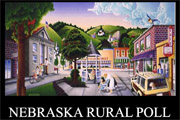Agricultural Economics, Department of

Nebraska Rural Poll
Date of this Version
2025
Document Type
Report
Citation
Nebraska Rural Poll Research Report 25-1, 2025
University of Nebraska-Lincoln
Abstract
This report details 943 responses to the 2025 Nebraska Rural Poll, the 30th annual effort to understand rural Nebraskans’ perceptions. Respondents were asked a series of questions about their confidence in institutions. Trends for some of the questions are examined by comparing data from the 2017 Poll and 2021 Poll to this year’s results. In addition, comparisons are made among different respondent subgroups, that is, comparisons by age, occupation, region, etc. Based on these analyses, some key findings emerged:
- Rural Nebraskans’ confidence in many institutions did not change much during the past eight years. However, more rural Nebraskans have a great deal of confidence in the presidency than they did in both 2017 and 2021. The proportion stating that they have a great deal of confidence in the presidency increased from 4 percent in 2021 to 17 percent this year. Conversely, fewer rural Nebraskans express a great deal of confidence in both the public safety agencies in their community and the public schools (K–12) in their community compared to four years ago. The proportion saying they have a great deal of confidence in the public safety agencies in their community decreased from 36 percent in 2021 to 25 percent this year. A similar trend occurred with the public schools in their community. The proportion having a great deal of confidence in the public schools in their community declined from 23 percent in both 2017 and 2021 to 17 percent this year.
- Overall, most rural Nebraskans have confidence in their local institutions (public safety agencies in their community, public schools in their community, and voting and election systems in their county). Most rural Nebraskans also have confidence in public libraries, community colleges, and public institutions of higher education. However, many express very little confidence in many national institutions (the Presidency, the U.S. House of Representatives, the U.S. Senate, and voting and election systems across the nation). Over one-half of rural Nebraskans have quite a lot or a great deal of confidence in public safety agencies in their community (68%), public libraries (68%), community colleges (62%), voting and election systems in their county (58%), public schools (K–12) in their community (56%), and public institutions of higher education (four-year colleges and universities) (51%). On the other hand, many rural Nebraskans have very little confidence in the following national institutions: U.S. House of Representatives (42%), U.S. Senate (42%), the Presidency and executive branch of government (38%), and voting and election systems across the nation (33%).
- Residents of the Panhandle are the regional group least likely to have confidence in the governor and state executive branch of government. Only 13 percent of Panhandle residents have quite a lot or a great deal of confidence in the governor and state executive branch of government, compared to at least one-quarter of residents of the other regions of the state. Conversely, over four in ten Panhandle residents have very little confidence in the governor and state executive branch of government.
- Older persons are more likely than younger persons to have confidence in the public safety agencies in their community. Almost eight in ten persons age 65 and older have quite a lot or a great deal of confidence in their public safety organizations, compared to one-half of persons age 19 to 29.
Included in
Agribusiness Commons, Agricultural and Resource Economics Commons, Civic and Community Engagement Commons, Community-Based Research Commons, Demography, Population, and Ecology Commons, Entrepreneurial and Small Business Operations Commons, Place and Environment Commons, Public Affairs, Public Policy and Public Administration Commons, Regional Economics Commons, Rural Sociology Commons


Comments
Copyright 2025, University of Nebraska-Lincoln. Used by permission